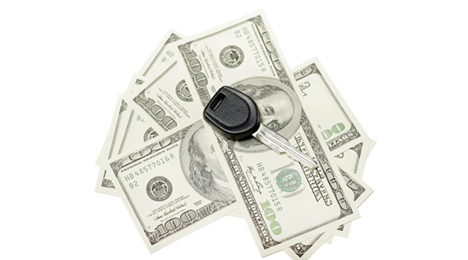David Blitzer, managing director and chairman of the index committee at S&P Dow Jones Indices, suspects that two factors could “hint of future default rate increases.” However, auto financing wasn’t one of the ones Blitzer mentioned on Tuesday when the June S&P/Experian Consumer Credit Default Indices were released.
The June auto loan default rate came in at 0.91 percent, down 1 basis point from May but 6 basis points higher than the same month a year ago.
The composite rate — based on a comprehensive measure of changes in consumer credit defaults according to data through June — ticked up 1 basis point from the previous month to 0.82 percent in June.
Analysts from S&P Dow Jones Indices and Experian noted the first mortgage default rate also inched up to 0.65 percent in June — 2 basis points higher than the prior month.
The bank card default rate remained unchanged in June, recording a default rate of 3.11 percent for the second month in a row.
Three of the five major cities included in the monthly update saw their overall default rates increase in June.
Dallas reported a default rate of 0.74 percent, up 5 basis points from May.
Miami’s default rate increased for the fourth consecutive month, up 4 basis points to a default rate of 1.31 percent.
Chicago’s default rate moved 3 basis points from the prior month to land at 1.01 percent.
New York recorded a default rate of 0.83 percent, down 6 basis points for the month.
Los Angeles reported a default rate of 0.67 percent, unchanged from May.
“Looking at the economy and credit conditions, American consumers are in good shape,” Blitzer said. “The S&P/Experian Consumer Credit Default Indices covering mortgages and auto loans are within a few basis points of the lowest levels seen in 12 years, while the bank card default index is only 62 basis points above its low.
“Economic conditions are also favorable with continued low inflation and low interest rates, declining unemployment, a rising stock market and modest economic growth,” he continued. “Consumers recognize the positive environment: consumer confidence is high and retail sales were up in June.”
Nonetheless, Blitzer closed his monthly assessment by looking forward.
“Despite the low default rates and positive economic conditions, some factors hint of future default rate increases,” he said.
“First, the bank card default rates have risen over the last 11 months and consumers continue to apply for additional accounts,” Blitzer continued. “Second, personal income growth is weak, only slightly ahead of inflation.
“At some point, inflation will move back to the Fed's 2 percent target or higher and interest rates could even creep up — events that could strain consumers unless gains in wages accelerate,” he went on to say.
Jointly developed by S&P Indices and Experian, analysts reiterated the S&P/Experian Consumer Credit Default Indices are published monthly with the intent to accurately track the default experience of consumer balances in four key loan categories: auto, bankcard, first mortgage lien and second mortgage lien.
The indices are calculated based on data extracted from Experian’s consumer credit database. This database is populated with individual consumer loan and payment data submitted by lenders to Experian every month.
Experian’s base of data contributors includes leading banks and mortgage companies and covers approximately $11 trillion in outstanding loans sourced from 11,500 lenders.
Auto financing metrics within the American Bankers Association’s latest Consumer Credit Delinquency Bulletin showed mixed movement in the first quarter as the overall reading prompted the assessment that consumers continued to manage their finances responsibly.
Delinquencies settled lower in seven of the 11 individual loan categories compared to the previous quarter, according to the ABA report that defines a delinquency as a payment that is 30 days or more overdue.
In the auto space, direct auto loan delinquencies — contracts arranged directly through a bank — rose from 0.75 percent to 0.81 percent. Meanwhile, indirect auto loan delinquencies — financing arranged through a third party such as a dealer — fell from 1.54 percent to 1.45 percent.
The composite ratio, which tracks delinquencies in eight closed-end installment loan categories, fell 3 basis points to 1.38 percent of all accounts, continuing a three-year trend of remaining well below the 15-year average of 2.23 percent.
“More people have jobs, wages are higher, home values have increased and consumers didn’t overextend themselves during the holiday season,” ABA chief economist James Chessen. “Even with a mild slowdown in the economy in the first quarter, consumers have shown a remarkable ability to ensure their debt levels are manageable.”
The bulletin indicated home-related delinquencies fell in two out of three categories. Home equity line delinquencies fell 3 basis points to 1.15 percent of all accounts, while home equity loan delinquencies rose 6 basis points to 2.74 percent of all accounts after falling 23 basis points in the previous quarter. The first quarter marks the first time since 2008 that both home equity loan and line delinquencies are at or below their 15-year averages.
Property improvement loan delinquencies fell 3 basis points to 0.89 percent of all accounts.
“As the housing market continues its slow and steady recovery, consumers have more valuable equity at stake, which makes their loan payments even more of a top priority,” Chessen said. “Growing equity also makes new home equity loans a viable option for qualified home owners.
“The market for home equity loans and lines will likely continue to grow as a larger pool of qualified borrowers looks to take advantage of low rates to make property improvements or pay off higher-interest debt,” he continued.
The bulletin also pointed out that bank card delinquencies fell slightly in the first quarter, dropping 5 basis points to 2.47 percent of all accounts. They remain well below their 15-year average of 3.71 percent.
Chessen expects low delinquency levels to continue amid stable economic conditions in the U.S. and consumers’ disciplined approach to credit.
“With household wealth near an all-time high and economic fundamentals holding steady, delinquencies are likely to remain near these historic lows,” he said.
ABA noted the Q1 composite ratio is made up of eight closed-end loans, and all figures are seasonally adjusted based upon the number of accounts.
Fitch Ratings shared its latest update on the topic becoming more of a pressing issue for finance company executives this year — the performance of subprime auto loan ABS.
While analysts noticed overall losses and delinquencies improved again in May, Fitch suspects that “the summer months do not figure to be as kind for the sector.”
According to the latest monthly index results released on Tuesday, 60-day delinquencies in the subprime sector improved nearly 2 percent month-over-month to 3.64 percent, though they are still 9 percent worse versus May of last year. Fitch indicated subprime annualized net losses posted “solid” performance in May, dropping to 6.52 percent. The May move marked a 12-percent decline compared to April. However, last month’s reading came in 52 percent above the level recorded a year ago.
“The April collection/May reporting period has produced the strongest performance metrics of the year, with consumers reaping the benefits of tax refunds and using them to pay down debts,” Fitch said.
“Looking ahead, performance metrics are likely to slow and losses to rise during the summer season,” the firm continued.
With tax season completed, Fitch is expecting subprime annualized net losses to climb within the range of 6.50 percent to 8 percent during the next four months.
“Current economic conditions appear mixed but healthy overall,” Fitch analysts said. “Job growth slowed materially in May — a bad sign which may indicate slower economic activity in coming months.
“However, the equities market continued to tick up with stock prices elevated, in part driven by strong fiscal support along with low interest rates and gas prices,” they went on to say.
In the prime space, Fitch reported that 60-day delinquencies slowed to 0.30 percent in May. That figure represented a 12-percent decrease month-over-month as the reading declined to the lowest level since May of last year.
Analysts added that annualized net losses in prime dipped by 12 percent month-over-month, settling at 0.40 percent. Prime delinquencies came in flat year-over-year, while annualized net losses jumped 32 perent higher.
“Prime and subprime auto loan ABS metrics displayed better results in May as delinquencies and losses declined,” analysts reiterated.
“Despite improvements over the past few months, Fitch believes auto ABS performance will slowly deteriorate again during the summer,” they continued. “Pressure on used-vehicle values will increase and drive loss severity, while weaker credit quality in recent 2013-2015 vintages will move loss frequency higher.”
Fitch recapped that the seasonally adjusted annual rate (SAAR) of new-vehicle sales was 17.4 million units in May, down from the same period in 2015.
“Used-vehicle demand remains fairly healthy but will continue to be pressured in 2016 from rising used-vehicle supply,” Fitch said.
“Gas prices have crept up over the past six weeks, which will support compact car vehicle values which may have hit a floor in May,” the firm continued. “Nevertheless, these models remain the weakest vehicle segment as current oil prices continue to drive consumers toward larger SUV and truck models.”
Overall, Fitch asserted that the used-vehicle market was fairly active in May with prices stable. The Manheim Used Vehicle Value Index was higher, albeit by a small margin, rising to 124.5 from 122.8 in April. The index was down by just over 1 percent from a year earlier.
Fitch upgraded 38 outstanding auto ABS tranches through early June, in line with the first six months of 2015.
“Despite slower asset performance this year for both the prime and subprime sectors, Fitch has a stable asset performance outlook for the sector in 2016, while the ratings\outlook is positive,” analysts said.
Fitch’s U.S. auto ABS indices comprise $103 billion of outstanding collateral, of which 63 percent is prime and 37 percent subprime. “Importantly, the total auto lending market hit a record level of $1.1 trillion in May,” the firm said.
Fitch’s prime auto ABS index only makes up approximately 6.2 percent of the total auto loans outstanding in the U.S., and the subprime index only 3.6 percent in total.
As the overall default reading recorded its lowest point dating back a decade, the auto loan segment of the S&P/Experian Consumer Credit Default Indices made another move away from the 1-percent level in May, dipping 5 basis points below the previous month’s reading.
According to data through May and released on Tuesday by S&P Dow Jones Indices and Experian, analysts indicated the auto loan default rate came in at 0.92 percent, the lowest mark since last September.
A year ago, the auto default reading stood at 0.86 percent.
The May composite rate, a comprehensive measure of changes in consumer credit defaults, also ticked 5 basis points lower on a sequential comparison, settling at 0.81 percent. Historical data going back 10 years that S&P and Experian share with this regular update showed how the composite level peaked in May 2009 at 5.51 percent — the climax of a steady climb that began 26 months earlier.
Now the composite rate has been below 1 percent for more than a year.
“Overall the consumers’ credit picture is very good,” said David Blitzer, managing director and chairman of the Index Committee at S&P Dow Jones Indices.
“Consumer credit default rates continue at the lowest levels in more than 10 years and well below those seen before the financial crisis,” Blitzer continued. “These positive developments are supported by continued gains in the economy: an unemployment rate under 5 percent, combined with increases in incomes and wages and stable prices.
“Debt service ratios remain close to record lows, while outstanding consumer credit and mortgage debt have risen modestly this year,” he went on to sy.
One segment of the economy that’s been watched by industry observers for much of the year has been activity associated with energy-producing areas, especially Texas, Oklahoma, New Mexico, Louisiana, West Virginia, North Dakota, Montana and Wyoming. During a recent webinar hosted by the Consumer Bankers Association, Moody’s Analytics senior director Cristian deRitis explained how finance providers of all types, not just in the vehicle space, can watch for pockets of performance deterioration even when the overall readings might be strong like they appear to be now.
After reiterating that collection of eight states, deRitis reiterated, “Obviously what all these states have in common is they are economies that are heavily dependent upon the oil extraction industry. Given the low price of oil that has benefitted consumers overall, it has certainly taken a toll on individuals in many of these oil patch states.
“That’s certainly some cause for concern and one of the reasons why we do a lot of analysis looking at these geographic segments, not so much to begin to suggest that subprime lending itself is the cause for higher delinquency,” he continued. “But it does introduce some risk into some portfolios.
“If you have a portfolio that's heavily exposed to the Northeast for example, you might want to keep an eye on what’s going on in Europe and how that might impact some of the export-related activities within the Northeast corridor,” deRitis went on to say. “Or on the West Coast, if you’re looking at a concentrated portfolio in California or other parts of the West, a scenario where Asia is impacted might be one to consider just like the oil price scenario has impacted some of these oil-impacted economies.”
Whether it’s in Bangor, Maine or Barstow, Calif., S&P and Experian noticed first mortgage defaults dropped by 6 basis points in May as compared to the prior month, coming in at 0.63 percent. Blitzer acknowledged bank card activity is a bit of a concern as the default rate ticked up another 2 basis points in May to 3.11 percent.
“One area worth following is the default rate on bank cards,” Blitzer said. “Between December 2015 and May 2016, the default rate on bank cards rose from 2.5 percent to 3.1 percent. It is up in the last three months, while the default rates on the other sectors followed here are down.
“The current level of bank card defaults is quite low. However the upward trend stands out compared to the other data series,” he added.
Tracking the major metropolitan areas S&P and Experian highlight in this report, four of the five major cities saw their overall default rates decrease during the month of May.
New York recorded a default rate of 0.89 percent, down 12 basis points for the month.
Dallas reported a default rate of 0.69 percent, down 7 basis points from April.
Chicago’s default rate decreased 5 basis points from the prior month, posting a default rate of 0.98 percent.
Los Angeles posted a default rate of 0.67 percent, down 4 basis points for May.
Meanwhile, Miami's default rate increased for the third consecutive month, up 6 basis points for a default rate of 1.27 percent.
Jointly developed by S&P Indices and Experian, analysts reiterated the S&P/Experian Consumer Credit Default Indices are published monthly with the intent to accurately track the default experience of consumer balances in four key loan categories: auto, bank card, first mortgage lien and second mortgage lien.
The indices are calculated based on data extracted from Experian’s consumer credit database. This database is populated with individual consumer loan and payment data submitted by lenders to Experian every month.
Experian’s base of data contributors includes leading banks and mortgage companies and covers approximately $11 trillion in outstanding loans sourced from 11,500 lenders.
At the same time Spireon announced it has reached 3 million active subscribers for its suite of GPS-based vehicle telematics solutions, the company also highlighted this week that it has a new chief executive officer.
Taking the reins as CEO is Kevin Weiss, who Spireon is asking to lead the next evolution of its strategic growth plan. That strategy includes expanding offerings for all major segments in vehicle telematics, including solutions for franchised and independent dealers, auto finance companies, small and enterprise fleets, rental car companies and consumer markets.
“The growing adoption of vehicle telematics proves that the Internet of Things (IoT) is not made up of distant technologies that we will see implemented far off into the future,” Weiss said. “Spireon is an IoT trailblazer and by hitting this new milestone, we are leading the way in providing connected devices and solutions that serve as a viable business differentiator and competitive advantage for our customers.”
Prior to joining Spireon, Weiss served as CEO of Unitrends, a global technology company that delivers end-to-end business recovery solutions. Prior to Unitrends, Weiss served as president and chief executive officer of multiple private-equity owned technology-enabled companies following his role as president of McAfee and senior sales and marketing leadership roles at IBM.
In addition to reaching 3 million active subscribers, Weiss comes aboard as Spireon achieved record-breaking sales for the first quarter of 2016, adding double-digit growth in revenue and units as compared to the same quarter last year. The quarterly results mark six consecutive quarters of double-digit growth for the company.
Spireon also achieved significant increases in customer satisfaction scores, with customer survey results showing overall satisfaction with the company at its highest sustained level since the survey's inception.
Jack Tracey, executive director of the National Automotive Finance Association, described the relationship between member finance companies and the Consumer Financial Protection Bureau as not exactly deteriorating but not necessarily improving significantly, either. He explained to SubPrime Auto Finance News the reason why.
“The industry would like to feel like it’s working cooperatively with the CFPB to improve situations and conditions in the marketplace now,” Tracey said. “But pretty much as it’s been from the beginning, everyone is continually concerned as to when the next shoe is going to drop or what is going to be the next thing the CFPB is going to focus on.
“In many cases, the CFPB’s approach to regulation is punitive rather than working with the industry,” he continued.
The CFPB certainly remains active, and it’s one of the major discussion points the NAF Association has in store for its 20th annual Non-Prime Auto Financing Conference. For the second year in a row, the organization is welcoming more than 350 finance company executives, service providers, legal experts and regulators to the Dallas/Plano Marriott Legacy Town Center in Plano, Texas, for the event that runs Wednesday through Friday.
Along with what might be percolating within the walls of the CFPB in Washington, D.C., Tracey also mentioned that another element to how the bureau is wielding its influence is coming to light for NAF Association members.
“I would also say there’s becoming an increased awareness of the CFPB working with various states so that a state will approach an issue rather than the CFPB,” Tracey said. “Attorneys general and regulators at the state level we believe are working in tandem with the CFPB, so there are multiple agencies and regulatory bodies that are approaching the industry with concerns.
“The industry is becoming increasingly aware of it and concerned about it,” he added.
What NAF Association members are also aware of is the steady rise of delinquencies. But finance companies and industry watchers do not appear to be sounding alarms.
As fourth quarter outstanding auto loan balances reached the highest level on record since Experian Automotive began publicly tracking the data in 2006, Melinda Zabritski reminded the industry how to view a slight uptick in 60-day delinquencies.
According to its most recent State of the Automotive Finance Market report, Experian determined that 30-day delinquencies dropped across the board during the fourth quarter, pushing the overall rate to 2.57 percent from 2.62 percent a year ago. Conversely, 60-day delinquencies rose from 0.72 percent to 0.77 percent over the same time period.
Experian mentioned that all lender types saw increases in the percentage of loans that were 60 days delinquent with the exception of credit unions, which remained flat year-over-year. But Zabritski — the senior director of automotive finance for Experian — pointed out that the percentage of loans that were 60 days delinquent is still below the percentage in Q4 2007, when it was 0.8 percent.
The report found that finance companies make up the largest portion of the $6.8 billion in loan balances that were 60 days delinquent. Finance companies — the category of originators that Experian said book vehicle installment contracts but do not generate commercial deposits — hold nearly 45 percent of these balances with a total dollar volume of $3.04 billion. They are followed by banks ($1.8 billion), captive finance companies ($1.2 billion) and credit unions ($737 million).
“While rates in the more severe delinquency category are up, it’s important to note that the increases are modest and relatively low from a historical perspective,” Zabritski said.
“Also, given that we’ve seen an increase in loans to subprime and deep-subprime consumers, it’s natural to see a slight uptick,” she continued. “Although not yet a cause for concern, the industry should keep an eye on this metric to see how it trends in the quarters to come.”
As Zabritski referenced, Experian reported that subprime and deep subprime contracts accounted for 20.3 percent of all open automotive loans, compared with 20.8 percent in Q4 of 2014.
After conferring with NAF Association members, Tracey offered a similar assessment.
“I would say there’s a focus on delinquency. I wouldn’t say it’s a huge level of concern, but there’s increased focus on it,” he said. “In my opinion, part of the concern is that it’s not the number of delinquent accounts, it’s the amount. Terms were extended so amortization is slower.
“Overriding that concern on anything that’s delinquent now is vehicle values,” Tracey continued. “They’re trending down because of the influx of leased vehicles into the market and other conditions in the remarketing area that cause the collateral values to be down.
“People are watching it because if vehicles are repossessed, there’s going to be an increased loss because of used-car values being down,” Tracey went on to say.
If account holders manage to maintain their payments, Tracey is confident the auto financing market will continue to hold its important place in the turning of both new and used vehicles at the paces the industry has seen during the past couple of years.
“I would say the principle reason car sales are exceeding or at least meeting the high expectations is because of financing,” Tracey said. “With lower rates available and a competitive marketplace, people are able and willing get into new and used cars.
“There’s a lot of competition in the non-prime area,” he continued. “Even in the higher rates that need to be charged with non-prime, it’s competitive, so to a certain extent there’s downward pressure on those rates, too. The competitive environment and the availability of financing at lower rates is driving the auto industry. If the auto financing industry pulls back it will have a pull-back effect on car sales as well.”
Conference highlights
Wednesday
3:45 – 4:30 p.m.
NAF/AFSA Non-Prime Auto Financing Survey
Dwayne Furmidge, Director Americas, Benchmark Consulting International will share an overview of the NAF Association’s 20th Annual Non-Prime Automotive Financing Survey. This session will provide insights that are not available anywhere else.
Thursday
3:45 – 4:30 p.m.
Economic Forecast – Used Car Market
Tom Webb, chief economist at Cox Automotive, will discuss auctions’ trends in pricing, volume, and buyer and seller behavior indicate about the overall automotive marketplace — from manufacturers, to dealers, to lenders, and to retail customers. This session will translate market data on used vehicles into information executives can use.
11:15 a.m. – 12 p.m.
ABS Markets
Amy Martin, team leader and senior director in the Structured Finance Ratings Group at Standard & Poors will recap current market trends in non-prime financing. Information will be provided on issuance volume, collateral and ratings performance and Standard and Poors’ outlook for the auto loan ABS market.
Friday
8:30 – 9:30 a.m.
Update from Committee on Financial Services
Rep. Jeb Hensarling is set to address the conference on House Financial Services Committee activity including committee interaction with the CFPB, pending last-minute demands on Capitol Hill.
9:30 – 10:15 a.m.
Owe Canada: How to take Advantage of the Growing Non-prime Market in Canada
Neil Abbott, partner at Gowling WLG in Canada, will highlight how below-prime lending is much more common today in the Canadian economy and it may be an opportune time for U.S. lenders to consider buying a Canadian loan portfolio or investing in Canada. This session will cover the similarities and differences between Canada and U.S. non-prime lending markets.
Santander Consumer USA president and chief executive officer Jason Kulas insisted the finance company has “more data than almost anyone else in the subprime space.” So when SCUSA cut back on its core non-prime retail originations by 15 percent during the first quarter, Kulas emphasized how that data helped to maintain “disciplined” underwriting standards.
"What we constantly do is we look back to prior vintages and leverage the performance that we are seeing into how we price new originations to make sure we’re doing everything we can to maximize the value going forward of those new originations," Kulas said when SCUSA hosted its first-quarter conference call with investment analysts.
“And so that process of optimizing the risk return happens right now to be impacting our subprime capture,” he continued. “But it’s not an effort to reduce our exposure to subprime. It’s again a result of this optimization process that we go through constantly.”
As much as Kulas and the SCUSA team examine their own data, the finance company boss acknowledged that Santander also is watching what other players in the subprime space are doing.
“On a comparative basis, it seems that there are markets willing to be a little bit more aggressive on certain pockets of those than we are right now,” Kulas said. “Look, we don’t see any concerning overall trend in terms of individual players. But I will point out that we are seeing some of the same trends we mentioned in the last quarter, where in general the larger players, the more sophisticated players with more data as a group have lost share to the smaller, maybe less sophisticated and in some cases less disciplined competitors.”
“We will continue to focus on maintaining the right risk, we’re balanced, and making sure we originate assets that come through cycles. And in future quarters, it could be a different result; it’s booking less subprime loans as a result of that process, not the overwriting goal,” he went on to say.
More of SCUSA’s data pointed to a retraction in the subprime space. Santander reported that its Q1 2016 net charge-off rate rose to 8.2 percent, up from 6.1 percent in the year-ago quarter. Meanwhile, because of the pressure from declining wholesale used-vehicle prices, SCUSA’s recovery percentage dipped to 51 percent in the first quarter, down from 59 percent a year earlier.
“Our losses are driven by the higher concentration of deeper subprime assets that we originated in early to mid-2015,” SCUSA chief financial officer Izzy Dawood said. “Based on our analysis and historical experience, we anticipate the deeper subprime assets will have this deeper loss curve earlier in the last cycle of the loan and then transition to follow a normal loss curve over the full life.”
Dawood also touched on how all the data SCUSA has at its disposal prompted him to describe 2016 as a “transition year” in regard to the ABS market.
“Clearly I think the market — especially the capital markets — are going through a transition phase as the Fed raises rates and as investors evaluate the risk return thresholds,” he said.
The auto loan component of the S&P/Experian Consumer Credit Default Indices dropped below 1 percent in April for the first time since last September.
According to data through April and released on Tuesday by S&P Dow Jones Indices and Experian, auto loan defaults recorded a rate of 0.97 percent, down 5 basis points from March. The reading broke a streak of six consecutive months where the default rate stood at 1 percent or higher. That string included the highest point in the past year when it was 1.05 percent back in February.
While dipping below 1 percent, the April reading wasn’t quite as low as the recent low point, which came last June when analysts pinpointed the reading at 0.85 percent.
Meanwhile, the April composite rate — a comprehensive measure of changes in consumer credit defaults — dropped 7 basis points from the previous month to land at 0.86 percent.
S&P and Experian reported that first mortgage defaults came in at 0.69 percent for April, down 8 basis points from the prior month.
The bank card default rate increased 17 basis points in April and 60 basis points year-to-date, recording a default rate of 3.09 percent.
Looking at three of the five major cities analysts watch for this monthly update, they noticed three metro areas posted an overall default rate increase during the month of April.
Miami reported a default rate of 1.21 percent, up 6 basis points from March.
New York recorded a default rate of 1.01 percent in April, up 2 basis points from the prior month.
Dallas posted a default rate of 0.76 percent, a 1 basis point increase from the previous month.
Chicago’s default rate remained flat at 1.03 percent in April.
Los Angeles was the only city to report a decrease with a 0.71 percent default rate, down 10 basis points from March.
David Blitzer, managing director and chairman of the Index Committee at S&P Dow Jones Indices, offered an upbeat assessment of the April data.
“For two months, the overall consumer credit default rate has dropped to new lows while the default rate on bank cards has climbed,” Blitzer said. “Since the financial crisis, consumers are paying more attention to their debts, particularly longer-term financial commitments such as homes and autos.”
Blitzer highlighted the Mortgage Debt Service Ratio — the percentage of disposable income going to service mortgage debt — is at its lowest point since 1980. He added the Total Debt Service Ratio, which includes loans with scheduled payments, is close to a record low.
Blitzer also mentioned the savings rate is now at about 5 percent of disposable income, slightly higher than its level in 2004-2006.
“In contrast to the low default rates on mortgages and auto loans, bank cards recently showed increased default rates,” Blitzer said. “The longer-term post-crisis decline in the bank card default rate leveled off in 2014. Since then, it has been in a range of 2.5 percent to 3.2 percent.
"Bank card, auto and mortgage default rates are all lower than their pre-financial crisis levels,” he continued. “However, the bank card rate is more volatile than the others and more sensitive to consumer spending trends. Whether the default pattern for bank cards stabilizes remains to be seen.”
A double-digit rise year-over-year in what TransUnion classifies as serious delinquencies above a level not seen in five years might prompt pessimistic auto finance observers and executives to reduce originations immediately and turn up the intensity in collections in hopes of keeping as many installment contracts current as possible.
When SubPrime Auto Finance News spoke with TransUnion’s Jason Laky on Wednesday morning soon after the credit bureau released its Q1 2016 Industry Insights Report, the senior vice president and automotive and consumer lending business leader for TransUnion did not look at the data with alarm. Rather, Laky focused on what he sees as the two primary drivers of increasing delinquencies — one of which he said is more pronounced than the other.
First, here are the numbers TransUnion shared.
Serious delinquency on auto loans (60 or more days past due) hit 1.12 percent in Q1 2016, the first time it has topped 1 percent in the first quarter since 2011. The delinquency level moved up by 13.1 percent year-over-year as the reading stood at 0.99 percent in Q1 2015.
Despite the yearly increase, Laky and TransUnion pointed out the delinquency rate remains below the level observed in Q1 2010, when it reached 1.21 percent.
“As we mentioned in the last quarter, there’s increase in delinquencies that’s occurring in the more energy-dependent states that we believe is the result of the oil-price decline and the impact that’s had on energy related services and industries,” Laky said about metrics in places such as North Dakota, Oklahoma and Texas.
“Folks who are involved and related to that are experiencing an economic shock, and delinquencies are up for lenders that are servicing customers in those areas,” he continued.
Development within energy states are “a small part of the story,” according to Laky, who elaborated further about how more paper attached to non-prime and subprime customers is going to generate a natural lift in delinquency.
“We’ve been tracking for years on how lenders are expanding their credit to non-prime and subprime consumers as the economy has gotten better and the lenders have gotten healthier and lending again to subprime consumers,” Laky said. “When you do that, you should naturally expect that the overall delinquency level for all consumers is going to go up, reflecting the change in mixture to add more subprime consumers.
“That’s why when you look back coming out of the recession, delinquency was higher than it is now,” he continued. “It went to a very low level because lenders pulled away from subprime lending. As their portfolios healed to reflect that, delinquencies were down below 1 percent. Each quarter as we’ve seen more lending into non-prime and subprime consumers, delinquencies are increasing slowly and past the 1 percent threshold again.”
In Q1 2016, TransUnion reported that 76.37 million consumers had an auto loan, an increase of 5 million from the first quarter of 2015. The number of consumers with an auto loan grew 7.1 percent from 71.29 million in Q1 2015.
“What we can say is for a consumer, their auto loan and car is a necessity in their lives,” Laky said. “Very few consumers live within walking distance or with easy public transit to everything they want to do, and not just for work but also their lives outside of work. As a result, most every adult consumer needs a car.
“For these more than 75 million consumers who have an auto loan, we haven’t seen change in that payment level very much in the past several years. So the idea of a particular payment for a particular consumer, it’s a necessity and part of their budget. We see it with the low delinquency levels in auto loans relative to other financing products. Again, it’s a core component of the consumer’s lifestyle. As a result, the loan payment is an important part of their wallet.”
Viewed one quarter in arrears to ensure all accounts are reported and included in the data, TransUnion also mentioned in its latest report that auto loan originations grew 5.4 percent year-over-year to 6.51 million in Q4 2015, up from 6.17 million in Q4 2014. The average new account balance (reported one quarter in arrears) reached $20,469 in Q4 2015, its highest level since the recession. The average new account balance increased 2.9 percent from $19,890 at year-end 2014.
“Conditions are very favorable right now for lending, being that the cost of funds still remains low,” Laky said. “There’s a strong consumer demand for loans and demand from consumers who are in good financial shape because we’re seeing continued employment growth and we’re seeing wage growth begin to catch up.
“That combination with consumer confidence makes for a consumer that wants to borrow. With economic conditions favoring lenders lending, as a result many are interested in growing their portfolio right now,” he added.
While also touching on how the subprime auto finance company is navigating challenges in both collections and rolling out securitizations, Consumer Portfolio Services highlighted that it closed the first quarter by originating the most contracts ever in a single month.
During Q1 of 2016 that closed on March 31, CPS purchased $312.3 million of new contracts compared to $269.2 million during the fourth quarter of last year and $233.9 million during the year-ago quarter. During the company’s quarterly conference call, chairman and chief executive officer Charles “Brad” Bradley Jr. wasn’t sure whether it was solely tax refund monies that pushed CPS to originate a record amount of paper in March, which happened to coincide with the 25th anniversary of the company.
“It’s really hard to figure out, and to be honest, I don’t know that we really care,” Bradley said.
“What we care is we’ve got a nice little kick in the first quarter, which we didn’t have in the previous two years,” he continued. “That enable us to have a strong originations. We actually got back to our 2007 levels. March was a record month in terms of originations in one month.”
The Q1 origination amount left the company's managed receivables total at $2.142 billion as of March 31 an increase from $2.031 billion as of Dec. 31 and $1.726 billion when the first quarter of last year finished.
All of the first-quarter origination activity coupled with its rising portfolio helped CPS to generate earnings of $7.2 million, or $0.24 per diluted share. The figures were down a bit year-over-year as net income in the first quarter of 2015 came in at $8.3 million, or $0.26 per diluted share.
CPS did generate a 17.1-percent increase in revenues as the Q1 figure was $100.6 million, up by $14.7 million above the year-ago amount of $86.0 million.
Cutting into the company’s net income was a 24.1-percent jump in total operating expenses as the Q1 figures climbed from $71.2 million to $88.4 million.
Looking at the financial statement from the perspective of pretax income, CPS sustained a 17.1-percent decrease year-over-year as the metric fell from $14.7 million to $12.2 million
Despite the income declines, Bradley defended CPS’ performance during his opening remarks to investment analysts.
“We’re still quite profitable, making lots of money,” he said. “We’re making more money than we ever made before and so we’re really doing pretty well at that.
“And so as much as we’re not personally all that happy with CPS’ performance on its own, if you hold this up to the rest industry, we look surprisingly great,” Bradley went on to say.
Looking at collections
CPS reported that its annualized net charge-offs for the first quarter came in at 7.57 percent of the average owned portfolio as compared to 6.64 percent a year earlier.
The company also mentioned delinquencies greater than 30 days (including repossession inventory) stood at 8.97 percent of the total owned portfolio as of March 31 as compared to 6.86 percent when Q1 of 2015 closed.
When discussing these topics, Bradley acknowledged that “collections remain a challenge.” He insisted that both the regulatory environment finance companies navigate nowadays as well as how consumers communicate are changing significantly as they would rather trade text messages than phone calls.
“We used to call people at home and the phone on the wall would ring,” Bradley said. “Today it is the phone in their pocket and they’re not always wanting to answer that phone. So you have to come up with new ways to do things.”
A look at securitizations
After the first quarter closed, Consumer Portfolio Services announced the closing of its second term securitization of the year, a $332.7 million deal. The April transaction was CPS’ 20th senior subordinate securitization since the beginning of 2011 and the third consecutive securitization to receive a triple-A rating on the senior class of notes from two rating agencies.
Even though the transaction didn’t happen during the reporting period CPS shared, Bradley still assessed how the auto ABS market is impacting the company’s performance.
“The price and cost of funds has gone up significantly over the last few quarters. It certainly different world than a year ago in terms of what it cost to get securitization done,” Bradley said.
Having said that the cost of funds still low when we look at our historical average in terms of what it cost to get deals done,” he continued. “There’s still lots of appetite, but the people in the market mostly want to get paid a little more. And so that’s sort of an interesting new dynamic in that market that might be somewhat challenging as we go forward, so we will see.”












